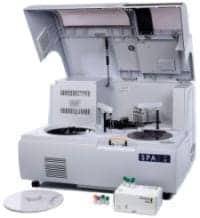Fitch Ratings has affirmed the following ratings of Quest Diagnostics Inc:
- Issuer Default Rating (IDR) at ‘BBB+’;
- Senior unsecured debt rating at ‘BBB+’;
- Bank loan rating at ‘BBB+’.
The ratings apply to $3.14 billion of outstanding debt. The Rating Outlook is Stable.
Quest maintains its leadership in independent clinical testing with a 15% market share of a highly fragmented clinical diagnostic testing market. Clinical testing generates over 90% of the company’s total revenues. Traditionally, the company leverages its asset base and broad product offering in order to maintain access to managed care payers and physicians; however, recent contractual negotiations to extend terms, a business mix shift, and the effect of the macroeconomic environment on patient behavior have led to revenue pressures during 2010, from both a pricing and volume perspective.
As such, Quest reduced revenue guidance twice in 2010 and now expects an approximately 1% decrease compared to the original forecast of 3% to 4% growth. Fitch’s main concern is the company’s ability to return to revenue growth, the key focus of Quest’s management team.
Ongoing cost reduction efforts since 2007 have supported margin expansion, as Quest realized over $500 million in annual savings by the end of 2009. EBITDA margins grew to 22.4% for the latest 12-month period ending June 30, 2010 from 20.7% at the end of 2007. Early in the year, Quest responded to the testing volume slowdown by eliminating headcount across the company, which should serve to minimize margin compression as revenues remain pressured throughout the year. Further margin support is derived from a reduction in bad debt expense to 4.0% of revenues in the first half of 2010 (down from 4.3% in 2009) resulting from improved billing and collection efforts. Fitch estimates margin compression throughout the intermediate term primarily resulting from increased marketing investment to counter revenue pressures.
Debt leverage has remained relatively stable since the end of 2008 and was 1.9 times (x) for the LTM period ending June 30, 2010, compared to 2.6x in 2007 (due to leveraging transactions). Despite the revenue and margin pressures, Fitch projects leverage to remain steady in the intermediate term absent significant asset purchases. Quest faces debt maturities through 2012 totaling nearly 34% of gross debt comprising approximately $166 million of 5.125% senior notes due November 2010, $160 million of 7.5% senior notes maturing July 2011, and $742 million of term loan debt fully payable by May 2012.
Fitch recognizes that free cash flow generation has been relatively consistent despite the revenue slowdown, and was $912.1 million for the LTM period ending June 30, 2010, compared to $755.8 million in 2009 (although the figure included a $308 million legal settlement). Free cash flow margins historically fall around 10%, while Fitch estimates margins to approximate 8.5% reflecting the projected operational challenges in the intermediate term. Quest’s management expects operating cash flow between $1.1 billion and $1.2 billion in 2010, and capital spending of $200 million. The company had cash and equivalents of $447.9 million at the end of the second quarter of 2010. Additional liquidity is provided by full capacity under a $750 million revolving credit facility due May 31, 2012 and full availability of a $525 million receivables securitization facility.
Capital deployment was focused on debt reduction in 2008 following a series of acquisitions in 2007; however, over the past few years, cash flow has been directed to aggressively repurchasing common shares as opposed to consummating tuck-in acquisitions, Quest’s stated first priority for cash flow. Year-to-date in 2010, Quest bought back approximately $426 million in equity with a goal in 2010 of fully completing the $750 million program that the Board authorized in January 2010. The company bought $500 million of shares in 2009.
Acquisition activity, focused toward assets that complement existing product and service capabilities and that increase geographical reach, has been modest since 2007. Fitch forecasts moderate spending for acquisitions, although a transforming transaction over the intermediate term to broaden its overall health care offering would not be inconsistent with the company’s acquisition history.
These rating actions reflect the application of Fitch’s current criteria which is available on Fitch’s website at www.fitchratings.com and specifically includes: ‘Corporate Rating Methodology’, dated Nov. 24, 2009, and ‘Liquidity Considerations for Corporate Issuers’ dated June 12, 2007.
Source: Fitch Ratings


